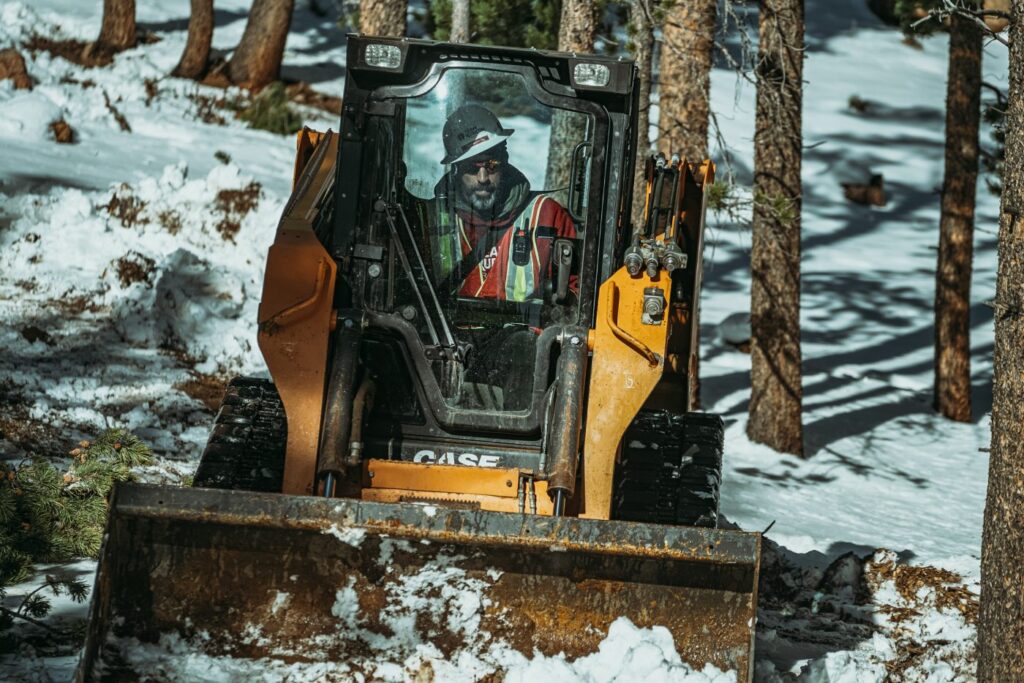In the snowy Colorado mountains in early November, Team Rubicon volunteers revved chainsaws and powered up skid steers. Some were novice chainsaw handlers and excavator drivers; others were more experienced. They were at the Salvation Army’s High Peak Camp, near Estes Park, to become proficient in chainsaw and heavy equipment operations. While the volunteers cut down trees and moved debris, learning to wield a saw or turn a skid steer with ease, they were also helping the local community with fire mitigation.
“In an extreme amount of forest in such a place like this, fire mitigation and fuel reduction is always important,” said Brian Wallace, High Peak Camp’s assistant director. In this part of Colorado, wildfires have long been a natural occurrence that allows the ecosystem to stay healthy. Lately, however, more homes and businesses are being built within areas susceptible to their dangers.

Attending the disaster training camp for heavy equipment operator training was Joe Brier, a firefighter and paramedic with the Albany Fire Department in Oregon, who acknowledged that, across the nation, more people are moving into such areas, known as Wildland Urban Interfaces (WUI). Not only does he recognize the importance of fire mitigation, he hopes that everyone takes part in it around their own home.
“It’s important for homeowners living in the forest to reduce the amount of fuel around their homes,” said Brier. “If a fire does happen, at least it will slow down because it doesn’t have the fuel to sustain the energy required to continue ravaging their landscape.”
As a firefighter who has fought more than 100 fires, Brier also personally appreciates it when communities maintain their areas against potential fires, as it makes it safer for first responders and allows them to quickly assess the situation and allocate resources to where they are needed the most, he explained.
“As more areas do fire mitigation, it greatly reduces the chance of having a catastrophic fire that puts us in harm’s way,” said Brier.
Preparing for Future Fire Seasons
According to a report in the American Political Science Review conducted by researchers from Loyola Marymount and Stanford University, every dollar spent on preparedness is worth about $15 in future damage mitigation. The price to prevent the spread of fires can not only save more money but also improve the safety and emotional wellbeing of everyone involved in a fire disaster.
Fire mitigation analysts look at everything from terrain to population density and weather patterns throughout the year to prepare for potential fire threats. Cold-and-wet conditions increase growth and abundance of vegetation; warmer temperatures turn dry brush into explosively flammable tinder. This combination of dense brush and dry conditions can mean bad news for communities. In California in 2019, a pattern of above-average rainfall season followed by record summer temperatures created more fuel for fires. As of November 2019, more than 6,000 total fires had burned nearly 200,000 acres, leaving more than 700 structures damaged or destroyed.

Team Rubicon has begun monitoring fire situations across the U.S. Southwest with the goal of preparing for future fire seasons—and helping mitigate against them. Jeremy Bersin, Team Rubicon’s Southwest disaster operations senior associate, has begun monitoring California fire hazard areas and sending out reconnaissance teams to better gauge the situation.
He and a team of Greyshirts recently linked up with different emergency operation centers, including some in Sonoma County during and after the recent Kincade Fire. They gathered real-time information to better understand how Team Rubicon might help in the future, whether by debris removal before fire season or assisting in recovery efforts after.
“We’re working on our capabilities to better serve California when it comes to this type of disaster and are looking at ways to plug-in to the longer-term recovery efforts,” said Bersin.
Guarding Against Natural Disaster Before It Happens
Back in Colorado, Clay Hunt Fellow and wildland firefighter Michael Lloyd led the sawyer training for what Team Rubicon calls its disaster training camp. Lloyd has fought wildfires in all parts of the United States and has responded to other types of disasters with Team Rubicon. In all the different elements he has faced, he believes fire is the only one where choices can be made to help guard against a natural disaster before it happens.
“We can provide fuel reduction to an area before a fire occurs, which would affect the lives of those in the [WUI] areas,” said Lloyd. “We are seeing a larger effort being made by communities to understand how fires impact us as a group, and we can make the right choices to minimize that impact of fire in our lives.”

With the selected trees toppled, and the debris moved into piles, the Greyshirts created a 900-foot fire break that would protect equipment—and a portion of the camp—from future fires.
“With all the beetle-killed trees, the volunteers from Team Rubicon not only made this place safer from wildland fires but also made our activity areas safer for the kids who will enjoy the camp next season,” said High Peak Camp’s Wallace.
For Greyshirts, that ounce of prevention provided hands-on heavy equipment operation training and the chance to cut a new path through the forest.



